How to use monotonic stack in Java
1. The next bigger element
Problem description
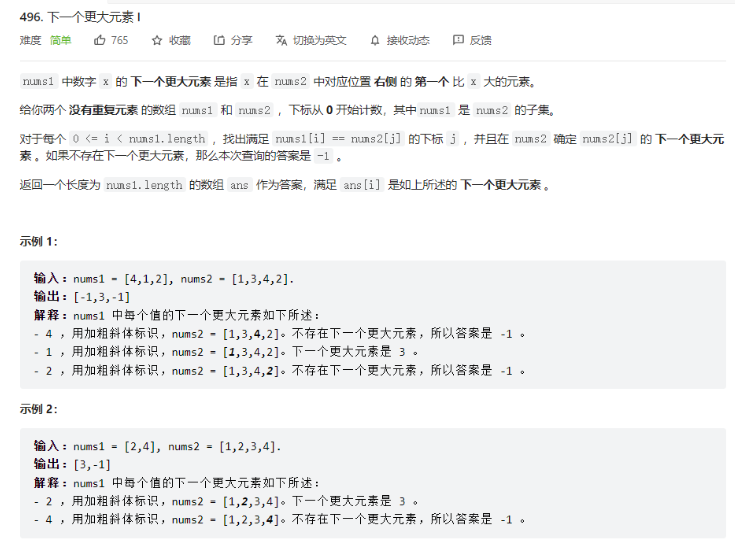
Detailed explanation of ideas
For this question, choose a more violent solution .
We first initialize a res array with the same length as nums to store the results. We traverse to take out the values in nums and search in nums2 until we find nums2[j] == nums[i]. We then Traverse from j in nums2 to find an array larger than nums[i] and return it. If it cannot find it, it returns -1.
Code and results
class Solution {
public int[] nextGreaterElement(int[] nums1, int[] nums2) {
int m = nums1.length, n = nums2.length;
int[] res = new int[m];
for (int i = 0; i < m; ++i) {
int j = 0;
while (j < n && nums2[j] != nums1[i]) {
++j;
}
int k = j + 1;
while (k < n && nums2[k] < nums2[j]) {
++k;
}
res[i] = k < n ? nums2[k] : -1;
}
return res;
}
}
2. Daily temperature
Question description
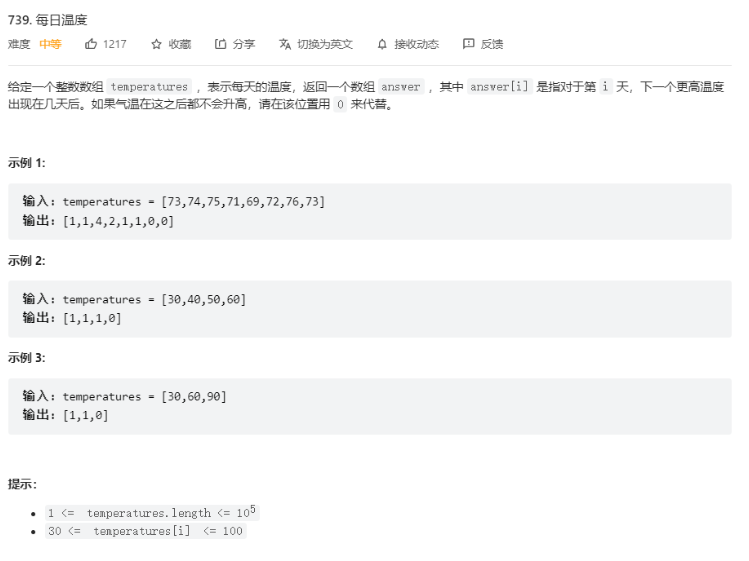
Detailed explanation of ideas
This question also uses a relatively violent method. Same as the previous question.
Double loop, obviously this method has higher time complexity. A method with lower time complexity is also provided here.
Monotone stack
What we maintain is a gap array, which is the result array. First create a stack and determine whether the stack is empty. If it is empty, push it directly to the stack. If it is not empty, compare it. The difference between the top element of the stack and the current element. If the current element is greater than the current element, the difference is put into the corresponding result array and the top element of the stack is popped off the stack. If the current element is smaller than the result array, it is pushed onto the stack.
Here is a link to animation, it’s a good idea to learn monotonic stack in animation.
Code and results
class Solution {
public int[] dailyTemperatures(int[] temperatures) {
int[] answer = new int[temperatures.length];
for(int i = 0 ; i < temperatures.length ; i++){
int res = 0;
for(int j = i+1 ; j < temperatures.length; j++){
res++;
if(temperatures[j] > temperatures[i]){
answer[i] = res;
break;
}
}
}
return answer;
}
}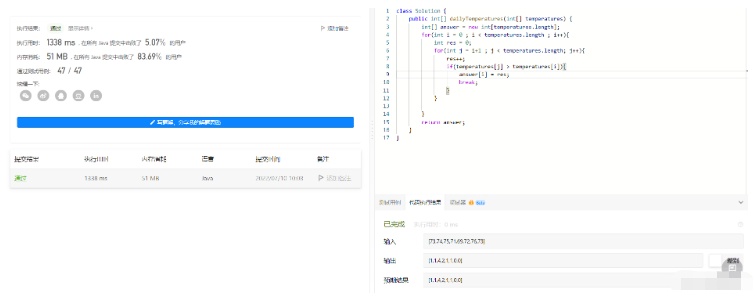
3. The next larger element II
Title description
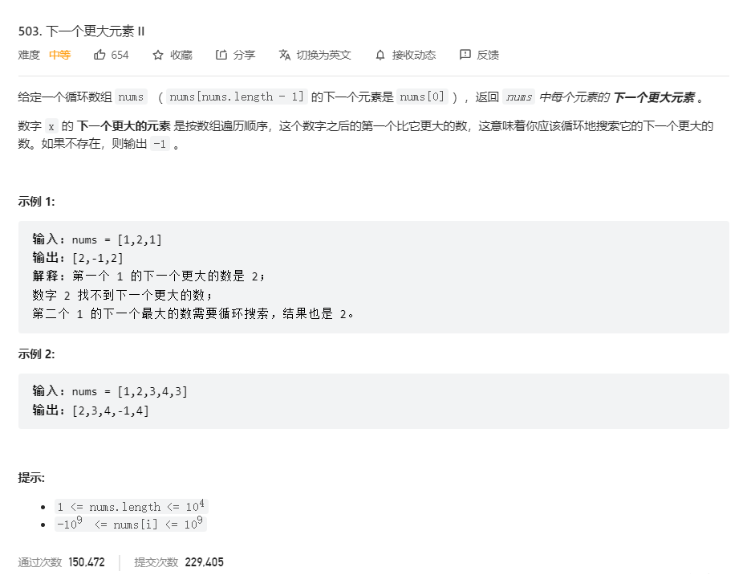
Detailed explanation of the idea
The idea of this question is the monotonic stack. Question 1 is a brute force solution. This question requires the use of a monotonic stack.
The principle is the same as the method in the second question, just pay attention to the loop. Go directly to the code. If you are not familiar with it, you can watch the video of the second question and then see this.
Code and results
class Solution {
public int[] nextGreaterElements(int[] nums) {
int n = nums.length;
int[] ret = new int[n];
Arrays.fill(ret, -1);
Deque<Integer> stack = new LinkedList<Integer>();
for (int i = 0; i < n * 2 - 1; i++) {//最多循环一次,只需要2*n-1就够用了
while (!stack.isEmpty() && nums[stack.peek()] < nums[i % n]) {
ret[stack.pop()] = nums[i % n];
}
stack.push(i % n);//利用取模来进行循环也是一种常用的方法
}
return ret;
}
}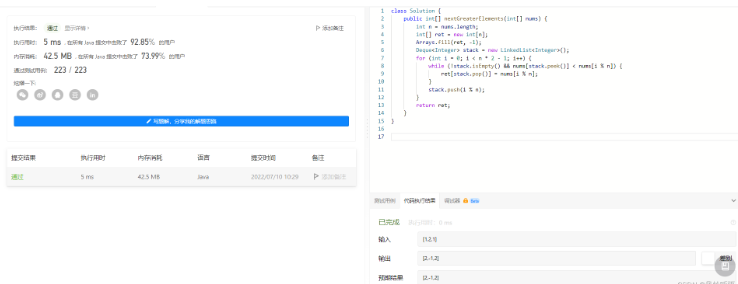
The above is the detailed content of How to use monotonic stack in Java. For more information, please follow other related articles on the PHP Chinese website!

Hot AI Tools

Undresser.AI Undress
AI-powered app for creating realistic nude photos

AI Clothes Remover
Online AI tool for removing clothes from photos.

Undress AI Tool
Undress images for free

Clothoff.io
AI clothes remover

AI Hentai Generator
Generate AI Hentai for free.

Hot Article

Hot Tools

Notepad++7.3.1
Easy-to-use and free code editor

SublimeText3 Chinese version
Chinese version, very easy to use

Zend Studio 13.0.1
Powerful PHP integrated development environment

Dreamweaver CS6
Visual web development tools

SublimeText3 Mac version
God-level code editing software (SublimeText3)

Hot Topics
 1382
1382
 52
52
 Perfect Number in Java
Aug 30, 2024 pm 04:28 PM
Perfect Number in Java
Aug 30, 2024 pm 04:28 PM
Guide to Perfect Number in Java. Here we discuss the Definition, How to check Perfect number in Java?, examples with code implementation.
 Weka in Java
Aug 30, 2024 pm 04:28 PM
Weka in Java
Aug 30, 2024 pm 04:28 PM
Guide to Weka in Java. Here we discuss the Introduction, how to use weka java, the type of platform, and advantages with examples.
 Smith Number in Java
Aug 30, 2024 pm 04:28 PM
Smith Number in Java
Aug 30, 2024 pm 04:28 PM
Guide to Smith Number in Java. Here we discuss the Definition, How to check smith number in Java? example with code implementation.
 Java Spring Interview Questions
Aug 30, 2024 pm 04:29 PM
Java Spring Interview Questions
Aug 30, 2024 pm 04:29 PM
In this article, we have kept the most asked Java Spring Interview Questions with their detailed answers. So that you can crack the interview.
 Break or return from Java 8 stream forEach?
Feb 07, 2025 pm 12:09 PM
Break or return from Java 8 stream forEach?
Feb 07, 2025 pm 12:09 PM
Java 8 introduces the Stream API, providing a powerful and expressive way to process data collections. However, a common question when using Stream is: How to break or return from a forEach operation? Traditional loops allow for early interruption or return, but Stream's forEach method does not directly support this method. This article will explain the reasons and explore alternative methods for implementing premature termination in Stream processing systems. Further reading: Java Stream API improvements Understand Stream forEach The forEach method is a terminal operation that performs one operation on each element in the Stream. Its design intention is
 TimeStamp to Date in Java
Aug 30, 2024 pm 04:28 PM
TimeStamp to Date in Java
Aug 30, 2024 pm 04:28 PM
Guide to TimeStamp to Date in Java. Here we also discuss the introduction and how to convert timestamp to date in java along with examples.
 Java Program to Find the Volume of Capsule
Feb 07, 2025 am 11:37 AM
Java Program to Find the Volume of Capsule
Feb 07, 2025 am 11:37 AM
Capsules are three-dimensional geometric figures, composed of a cylinder and a hemisphere at both ends. The volume of the capsule can be calculated by adding the volume of the cylinder and the volume of the hemisphere at both ends. This tutorial will discuss how to calculate the volume of a given capsule in Java using different methods. Capsule volume formula The formula for capsule volume is as follows: Capsule volume = Cylindrical volume Volume Two hemisphere volume in, r: The radius of the hemisphere. h: The height of the cylinder (excluding the hemisphere). Example 1 enter Radius = 5 units Height = 10 units Output Volume = 1570.8 cubic units explain Calculate volume using formula: Volume = π × r2 × h (4
 How to Run Your First Spring Boot Application in Spring Tool Suite?
Feb 07, 2025 pm 12:11 PM
How to Run Your First Spring Boot Application in Spring Tool Suite?
Feb 07, 2025 pm 12:11 PM
Spring Boot simplifies the creation of robust, scalable, and production-ready Java applications, revolutionizing Java development. Its "convention over configuration" approach, inherent to the Spring ecosystem, minimizes manual setup, allo




